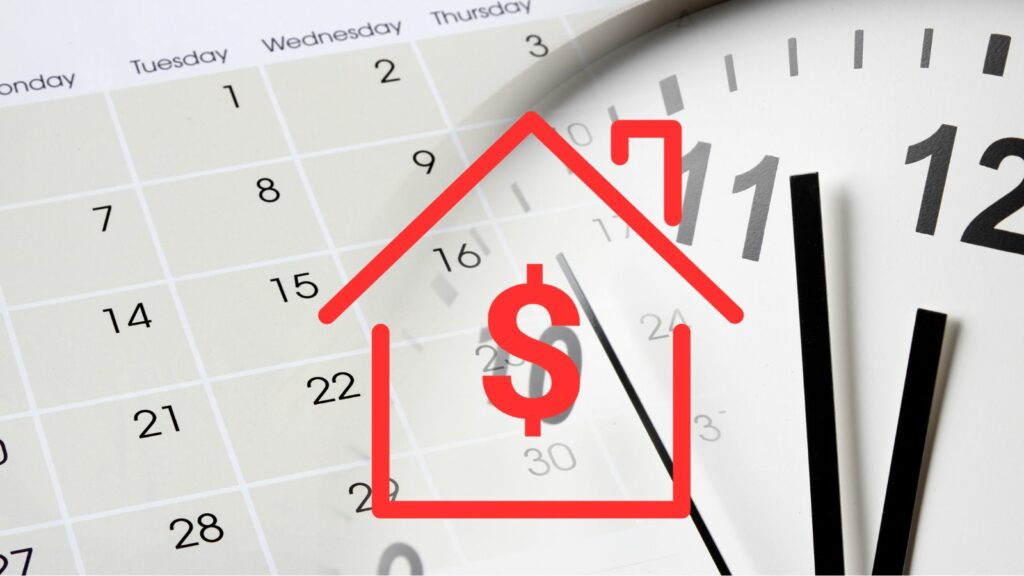The timeless quest for a place called ‘home’ often leads us to one pivotal question, “When is the ideal time to buy?” While house hunting is a thrilling expedition, knowing when to make that all-important leap can be the game-changer in finding a house and a true haven. As you navigate this journey, understanding the rhythm of the real estate market can be your greatest asset.

Setting the Stage: The Art of Perfect Timing in Real Estate
In the intricate dance of real estate, timing doesn’t just have a step – it leads the entire choreography. Navigating the property market without understanding timing is akin to setting sail without a compass. While the real estate market’s winds and currents can be unpredictable, timing’s importance remains unchallenged and pivotal.
A deep comprehension of the market’s tempo is at the heart of every successful home purchase. Like in nature, where every season brings unique beauty and challenges, the real estate market ebbs and flows in cycles. When deciphered accurately, these cycles can yield significant advantages in price, property options, or even the ease of the buying process.
But what sets the pace for these cycles? A multitude of factors come into play. With fluctuating interest rates and job markets, the economy paints broader strokes. At the same time, neighborhood developments and seasonal shifts add more localized hues. Personal milestones, like changes in family dynamics, career moves, or even evolving lifestyle choices, add their unique tints to this intricate mosaic.
Historical Market Trends: A Journey Through the Real Estate Timeline
Real estate doesn’t stand still. It evolves, shaped by myriad forces, from socio-economic shifts to technological innovations. Understanding how these trends have played out historically can give prospective homebuyers a more informed perspective. Let’s embark on a journey through the real estate timeline.
Patterns from the Past
The Boom and Bust of the Early 2000s: At the turn of the millennium, the housing market experienced a rapid ascent, marked by skyrocketing property values. However, this exuberance was short-lived, culminating in the housing crisis of 2008.
The Rise of Urban Living: As the 21st century progressed, urban centers, especially those with burgeoning tech industries, witnessed a surge in demand. Condos and lofts became the homes of choice for many seeking the conveniences of city living.
The Green Revolution: Eco-consciousness made its mark on real estate, too. By the 2010s, there was an escalating demand for energy-efficient homes, solar panels, and sustainable materials.
The Digital Shift: As technology embedded itself into our daily lives, how we searched for homes changed. Online listings, virtual tours, and real estate apps became indispensable tools for modern homebuyers.
Cyclicality: The Heartbeat of Real Estate
The housing market doesn’t follow a linear path but moves in cycles. Boom phases occur when demand outpaces supply and prices rise sharply. These booms frequently lead to corrections or even crashes. Conversely, downturns and buyer’s markets, where supply surpasses demand, can present golden opportunities for savvy buyers searching for a bargain. Recognizing and respecting this cyclicality can be a key asset for anyone purchasing a home.
Diving into these historical trends offers lessons and a compass, guiding prospective buyers in making emotionally satisfying and financially astute decisions.
Seasonal Dynamics of Real Estate: Navigating the Market's Changing Tides
The real estate market is much like the changing seasons. Each phase presents a unique backdrop, influencing buyer behavior, property availability, and pricing. While the idea of an “ideal time” to buy might vary based on personal circumstances, understanding the seasonal ebb and flow can equip potential homebuyers with valuable insights, positioning them for a well-timed plunge into property ownership.
Spring: The Awakening Market
As nature revitalizes, the property market experiences its own kind of bloom in spring. This season witnesses a burst of listings, with many sellers choosing it as the optimal time to showcase their homes. The appeal is undeniable; gardens are lush, and landscapes depict rejuvenation, giving properties a more picturesque feel. However, this allure also means a surge in homebuyers, leading to heightened competition. It’s not uncommon to find bidding wars, especially in coveted neighborhoods. With this competition, prices can see an upward push.
Summer: Relocation and Revelations
With its long days and warmer temperatures, summer often brings a sense of urgency to the housing market. Families aim to relocate, eager to settle before the next school year begins. The convenience is evident: moving during the summer can be logistically simpler, avoiding the challenges of mid-school-year adjustments for kids. However, this convenience can come at a cost. With the heightened demand, summer can sometimes introduce peak pricing, especially in family-friendly areas. Additionally, house visits during scorching days can be a less comfortable experience.
Fall: Opportunities Amidst the Autumn Leaves
By the time fall arrives, the rush of the spring and summer markets begins to slow. This change of pace can be advantageous. Sellers who didn’t close deals in the earlier busy months might be more inclined to negotiate, opening doors for potential bargains. The mild weather makes it a pleasant time for property visits and relocations. On the flip side, there’s a noticeable dip in listings as winter approaches. Some buyers might find options limited, especially seeking something very specific.
Winter: The Chilled Market’s Warm Deals
Winter introduces a quieter real estate scene. With fewer buyers braving the cold, those who venture out often face less competition. This reduced rivalry can lead to more flexible pricing, with sellers more open to negotiating, especially if their properties have been on the market for a while. Yet, challenges arise, too. Property listings are generally scarcer, and the cold weather, especially in snow-prone regions, can make moving a logistical challenge. Snow or winter conditions might mask underlying issues, making house inspections trickier.
Each season brings its own set of opportunities and challenges. Savvy buyers can capitalize on these patterns, ensuring their purchase aligns with market dynamics and personal preferences.
Economic Factors: The Financial Pulse of Real Estate
Navigating the real estate landscape requires more than just a keen eye for property. The undercurrents of the broader economy play a substantial role in shaping housing trends. Whether it’s the ebb and flow of interest rates, the vigor of the job market, or the balance between housing supply and demand, economic factors can significantly impact a buyer’s experience.
Interest Rates
Interest rates play a pivotal role in the real estate market. When they are low, potential homeowners often find it more affordable to borrow money, resulting in lower monthly mortgage payments. Conversely, higher interest rates can make borrowing costlier, potentially pushing some buyers out of the market. Keeping an eye on the Federal Reserve’s decisions is crucial, as their moves, influenced by broader economic conditions, can signal upcoming rises or drops in interest rates, helping prospective buyers time their purchases.
Job Market and Economic Health
The economy’s overall health and the job market significantly influence buyer confidence. During economic booms, with job security and rising wages, more people feel equipped to buy homes. This heightened demand can drive up property prices. On the other hand, during economic downturns, job uncertainties may deter potential buyers, leading to decreased demand and possibly more favorable prices. Moreover, regional variations are crucial. For instance, a city experiencing a tech boom might see a surge in housing demand, even if the broader national economy is facing a downturn.
Housing Demand and Supply
The dance between housing demand and supply determines whether we’re in a buyer’s or seller’s market. A buyer’s market arises when more homes are available than people looking to buy. In this scenario, buyers often have the upper hand in negotiations, leading to potentially lower prices or other favorable terms. Conversely, in a seller’s market, demand outstrips supply. Homes might sell quickly, sometimes even above the asking price, as buyers compete for limited listings.
Understanding these economic underpinnings can provide a valuable lens for potential homebuyers. With a finger on the financial pulse, one can make more informed, strategic decisions in their home-buying journey.
Personal Financial Preparedness: Setting the Stage for Your Home Purchase
Stepping into the world of homeownership is as much about personal financial readiness as it is about market dynamics. Ensuring you’re economically prepared can be the linchpin to a smooth home-buying experience. From understanding your budget to navigating the intricacies of credit scores and down payments, personal financial preparedness sets the tone for your real estate journey.
Budgeting
Before embarking on the journey to homeownership, it’s essential to take a comprehensive look at your finances. Determining what you can afford goes beyond just the price tag of a home. It’s about assessing the potential monthly mortgage payments and the hidden costs of owning a property, such as maintenance, insurance, and taxes.
Credit Score and Mortgage Preparedness
Your credit score plays a pivotal role in the home-buying process. It greatly influences the kind of mortgage rates you’re eligible for and can be a determining factor in loan approval. Understanding this role is crucial for potential homeowners. Before actively searching for a home, it’s wise to understand the difference between mortgage pre-approval and pre-qualification. While pre-qualification estimates what you might be able to borrow, pre-approval goes further by detailing the loan amount the lender is willing to offer.
Down Payment
The down payment often becomes a focal point for potential homebuyers. Traditional mortgage options typically require a 20% down payment, but several low down payment alternatives exist today. Each comes with its own set of advantages and drawbacks. Beyond just understanding these options, it’s also vital to have a saving strategy in place. Whether allocating a portion of monthly income or exploring other financial avenues, a planned approach to saving can make the down payment hurdle less daunting.
Potential homebuyers, gearing up to make one of their most significant financial decisions, must thoroughly prepare on the personal economic front. It paves the way for a smoother purchase process and ensures long-term financial stability and peace of mind.
Life Considerations: Beyond Dollars and Cents
When contemplating a home purchase, there’s more to consider than just the financial aspects. Life’s ever-evolving chapters introduce various variables that can shape and influence the decision to buy a home. From career changes to family dynamics and even visions of retirement, understanding how these personal factors fit into the home-buying equation is vital.
Relocating for a Job
A new job opportunity in a different city or state presents unique challenges and opportunities for potential homebuyers. The excitement of a new role often comes with weighing housing options against the backdrop of this new job opportunity, which means considering commute times, understanding the new area’s real estate market, and ensuring that the move aligns with long-term career and personal goals.
Family Dynamics
Families are living entities, always growing and evolving. As such, housing needs can change significantly over time. A growing family might need to upsize to accommodate more members. At the same time, empty nesters might look to downsize for a more manageable space. Beyond just the size of the home, factors like school districts become pivotal for those with school-aged children. Moreover, proximity to extended family can also play a role, especially if regular visits or shared caregiving responsibilities are in the picture.
Retirement
Purchasing a home takes on a different hue for those nearing retirement or already in their golden years. It’s less about investment and more about lifestyle and comfort. Timing becomes crucial, as the objective might be to settle into a peaceful community or be closer to recreational facilities. The layout of the home, potential maintenance requirements, and proximity to healthcare facilities are all considerations that come to the forefront.
Buying a home isn’t just a financial decision. It’s a decision deeply interwoven with the tapestry of life’s milestones and moments. Recognizing and planning for these considerations ensures that the chosen home becomes a haven aligned with one’s life journey.
External Circumstances: The Bigger Picture in Home Buying
Every homebuyer operates within a context much larger than personal circumstances and immediate surroundings. Our interconnected world ensures that events at national and global scales ripple through to individual decisions, including those related to real estate.
National and Global Events
The housing market isn’t isolated; it reacts and adapts to significant global events. National occurrences, like elections, can introduce or amend housing policies, possibly impacting property values or buyer incentives. Beyond our borders, global events such as economic downturns, trade wars, or international crises can influence investor confidence, lending rates, and even the general public’s sentiment toward buying property. Recent history shows that global pandemics can introduce unpredictability, affecting supply chains, labor markets, and buyer behaviors. In such volatile times, potential homebuyers must remain adaptable, informed, and perhaps even more cautious, ensuring their decisions account for larger, unfolding dynamics.
Local Infrastructure and Development
A more localized but equally significant external factor is the development trajectory of a particular region or city. Infrastructure projects, like new highways, public transportation systems, or utility upgrades, can dramatically influence property values. Similarly, introducing new schools, hospitals, or recreational centers can make an area more desirable for specific demographics. Prospective buyers should remain attuned to planned local developments, which can indicate potential future growth (or decline) in property values.
In the broader picture, personal considerations and financial readiness remain crucial, but buyers must actively acknowledge the impact of larger events and developments. A well-informed buyer will always consider these external circumstances, using them as additional compass points in their home-buying journey.
Navigating the Path to Your Dream Home
Timing can make all the difference in the intricate dance of home buying. It’s a delicate balance of personal finances, life circumstances, external influences, and market dynamics. But remember, while all these factors offer valuable insights, the true essence of a home extends beyond just timing and market strategies—it’s about finding a place that resonates with your heart and aligns with your future aspirations.
As you contemplate this significant decision, don’t journey alone. A seasoned real estate agent brings market expertise and experience from helping others in similar positions. They can guide you, provide clarity, and help ensure your decision is both timely and timeless.
Ready to make your move? Contact your real estate agent today and embark on securing your dream home. Your future awaits.


